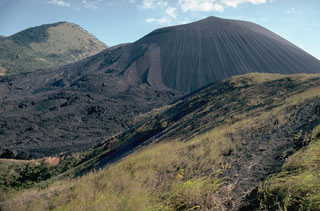Report on Cerro Negro (Nicaragua) — September 2000
Bulletin of the Global Volcanism Network, vol. 25, no. 9 (September 2000)
Managing Editor: Richard Wunderman.
Cerro Negro (Nicaragua) Low seismicity; fumarole temperatures in March-April 2000
Please cite this report as:
Global Volcanism Program, 2000. Report on Cerro Negro (Nicaragua) (Wunderman, R., ed.). Bulletin of the Global Volcanism Network, 25:9. Smithsonian Institution. https://doi.org/10.5479/si.GVP.BGVN200009-344070
Cerro Negro
Nicaragua
12.506°N, 86.702°W; summit elev. 728 m
All times are local (unless otherwise noted)
Following the eruptive activity of 5-7 August 1999 (BGVN 24:11), seismicity dropped to low levels, with no more than 12 events/month detected through November 1999. The monthly earthquake totals increased to 31 and 32 events, respectively, during December 1999 and January 2000. These numbers continued to slowly increase, reaching 41 events in February and 46 events in March 2000. Total monthly earthquakes in April dropped to 20 events. Low-level tremor was constant throughout the September 1999-April 2000 period.
Fieldwork during March and April 2000 allowed observations of the August 1999 cones and vent, but no changes were noted. New temperature measurements of fumaroles located in the interior of the main crater were also taken during March and April (table 2). Fumaroles 1, 2, and 3 exhibited a consistent temperature increase. The much hotter fumaroles in March (4, 5, and 6) were more variable, and had cooled by late April.
Table 2. Fumarole temperatures from the main crater area at Cerro Negro, July 1999-April 2000. Measurements were made with a thermocouple in July 1999, December 1999, and March 2000; an infrared pistol was used in April 2000. Courtesy of INETER.
| Date | Fumarole 1 | Fumarole 2 | Fumarole 3 | Fumarole 4 | Fumarole 5 | Fumarole 6 |
| Jul 1999 | 45.0°C | 72.0°C | -- | -- | -- | 85.0°C |
| Dec 1999 | 69.8°C | 60.5°C | 58.0°C | 69.7°C | 232°C | 147°C |
| Mar 2000 | 73.3°C | 60.5°C | 97.0°C | 318°C | 201°C | 206°C |
| 27 Apr 2000 | 91.0°C | 236°C | 110°C | 193°C | 176°C | -- |
Geological Summary. Nicaragua's youngest volcano, Cerro Negro, was created following an eruption that began in April 1850 about 2 km NW of the summit of Las Pilas volcano. It is the largest, southernmost, and most recent of a group of four youthful cinder cones constructed along a NNW-SSE-trending line in the central Marrabios Range. Strombolian-to-subplinian eruptions at intervals of a few years to several decades have constructed a roughly 250-m-high basaltic cone and an associated lava field constrained by topography to extend primarily NE and SW. Cone and crater morphology have varied significantly during its short eruptive history. Although it lies in a relatively unpopulated area, occasional heavy ashfalls have damaged crops and buildings.
Information Contacts: Wilfried Strauch and Virginia Tenorio, Dirección General de Geofísica, Instituto Nicaragüense de Estudios Territoriales (INETER), Apartado 1761, Managua, Nicaragua (URL: http://www.ineter.gob.ni/).

